Type 2 diabetes (T2D) and its complications has become a global public health burden1,2. The number of patients with diabetes is projected to increase from 382 million to 592 million during 25 years, and one in ten of the world's population could suffer from diabetes by 20352. The disease is one of the non-communicable diseases with a sharply increasing rate in Vietnam. Nationwide surveys have indicated that T2D prevalence increased from 2.7% in 20033 to 5.7% in 20124. T2D is a serious disease due to silent onset and long-term progression without clinical signs. Most T2D patients in the general population are not aware of their condition, and they are diagnosed with T2D after a regular health check or when T2D complications appear. T2D can progress to serious complications, including kidney failure, hypertension, blindness, foot lesions, stroke, and death if the condition is undiagnosed in its early stage and not treated effectively.
Situated in the Red River Delta, Ha Nam Province has a population of about 1 million people, who live mainly in rural areas (108 rural communes and six urban wards)5. The age- and sex-standardized prevalence of T2D was 3.7% (95% confidence interval [CI] 2.7−4.7%) in the population aged 40-64 years in 2011. The prevalence of T2D increased with age and was higher in urban areas than in rural areas. The prediabetes prevalence (14.6%) was four times higher than T2D prevalence. In particular, more than 70% of T2D patients in the general population did not know of their condition6. People with prediabetes have a high risk of developing T2D, so they need knowledge of T2D prevention and early intervention through nutrition and physical activity. Patients with diabetes need to be detected in the early stage of the disease, managed and treated effectively to prevent diabetes complications.
Knowledge about diabetes and attitude towards the condition are known to affect compliance and play an important role in diabetes management. Knowledge of T2D is a prerequisite for individuals and communities to take action on control of the disease. Diabetes communication and education with consequent improvement in knowledge, attitudes and skills will lead to better control of the disease and is widely accepted to be an integral part of comprehensive diabetes care7. Thus, studies on knowledge and attitude towards T2D have been published in many countries. Low levels of diabetes-related knowledge are reported in developing countries, including Kenya8, Mongolia9, Nigeria10, and India11, while knowledge is much higher in developed countries12. In Vietnam, there is a paucity of information about knowledge and attitudes concerning T2D, its complications and the health impact of diabetes. A report in a southern province13 showed the very low comprehensive knowledge on T2D control, but data from other regions of the country are sparse, especially from the northern side. Therefore, the study aimed to identify the knowledge and associated factors on control of T2D among a Vietnamese population in Red River Delta region. The study ought to provide evidence to local authorities and public health decision-makers to implement communication and education activities to improve the population's knowledge about control of T2D.
Study design and sample recruitment
The study was designed as a cross-sectional survey, directly interviewing subjects aged 40-64 years in Ha Nam Province in order to complete a structured questionnaire. This study was integrated in the large population-based research to investigate the magnitude of chronic and non-communicable diseases in Ha Nam Province from July to November 2011. Details of the survey have been reported previously6. In this study, rural and urban areas are classified according to the Vietnam administrative system. The rural areas include communes (a commune has one or several villages) where agriculture is the chief source of livelihood, along with fishing, pottery, and handwork. The urban areas are composed of wards in the city where industry, services, and trade are the main source of livelihood.
A random sample representative of Ha Nam's population aged 40-64 years was recruited by the two-stage sampling method. In the first stage, 30 clusters (28 communes and 2 wards) were selected from all 114 communes and wards in Ha Nam Province, by the probability proportion-to-size method. In the second stage, simple random sampling was used to recruit 100 participants in each cluster. Exclusion criteria for potential participants included pregnant women, critically ill subjects, and subjects with mental disorders. On the days of the survey, 290 (9.7%) subjects were absent or excluded due to being <40 or >64 years old. In addition, the obtained data from 190 participants were not completed. As a result, data from 2580 subjects were used to analysed in the study. Thus, the response rate was 86%. The sample size of 2580 subjects was large enough to estimate the prevalence of 5%, with relative precision of 0.25 of the real prevalence in the 95% CI, and design effect of two.
Data collection and analysis
The surveyors were trained, and practised how to interview subjects to complete a structured questionnaire. The questionnaire was validated at this stage. The questions were open style without suggestion to avoid bias. The surveyors did the face-to-face interview to collect data in the local health centres. The surpervisor followed up the survey team to support the survey and check data collected.
The continuous data were presented as mean (±standard deviation [SD]) or median (interquartile range). Knowledge rate was shown in the general population and by gender, age, residence, educational level, and occupation. To evaluate the overall knowledge of diabetes control, 14 questions were used to calculate the total score of 100 points, which included 14 points of general awareness of T2D, 7 points of T2D complications, 7 points of T2D risk factors, 24 points of prevention activities, 40 points of treatment activities, and 8 points of attitude towards T2D. Total knowledge score was classified into the following four categories: highly insufficient (≤25 points), insufficient (26-50 points), satisfactory (51-75 points), and highly satisfactory (>75 points). Inadequate knowledge was classified as a score of less than 50 points of total knowledge score. Knowledge and attitudes between urban and rural areas were compared using χ² test or Fisher's exact test. Association between inadequate knowledge and variables was evaluated using multivariate logistic regression. EpiData software (EpiData Association; www.epidata.dk) was used to enter and check data; Statistical Package for Social Sciences v16 (SPSS Inc; www.spps.com) and Stata v11.0 (Statacorp; www.stata.com) were used to perform statistical procedures. A two-sided p-value of <0.05 was considered statistically significant.
Ethics approval
The Ethics Committee of the National Institute of Hygiene and Epidemiology, Vietnam, approved the protocol of the study (No. 14/HDDD). All participants provided written informed consent before entering the study.
Of the total 2580 participants, 35% were men, and 94.3% lived in rural areas. The newly diagnosed diabetic cases comprised 75% of the 93 diabetic subjects. The frequencies of elementary, intermediate, secondary, and post-secondary levels of education were 10.0, 61.6, 13.6, and 15.3%, respectively. Mean age (SD) of subjects was 51.3 (6.6) years. Occupations were farmer (71.7%), office worker (13.8%), factory worker (5.2%), artisan (2.2%), and housewife and retired person (7%).
Table 1 shows the general knowledge about the seriousness and complications of the disease. There was a low rate (3.8%) of subjects understanding that 'Diabetes is the raised blood sugar status causing disease', 89% of population understood 'T2D is a serious disease', 63.4% knew the disease can lead to death and 15.2% knew that 'T2D causes many serious complications'. No more than 10% population understood T2D complications.
Overall, urban inhabitants had significantly better knowledge than rural inhabitants. That is, urban people were more likely to know that 'Diabetes is the raised blood sugar status causing disease' (12.3% vs 3.3%),'T2D causes many serious complications' (30.1% vs 14.3%). Similarly, with regards to prediabetes, urban people were more likely than rural ones to know that 'Blood sugar level is higher than normal, but it's not yet high enough to be classified as type 2 diabetes' (21.2% vs 3%), and 'Person with prediabetes is at high risk of developing type 2 diabetes' (11% vs 0.8%).
Table 2 presents Ha Nam inhabitants' knowledge of risk factors and prevention of T2D. Overweight and obesity were the most recognized (30.1%), followed by eating too much (9.6%), hypertension (5.8%), family history of T2D (3.2%), and insufficient physical activity (2.6%). The others were cited less than 1%: age over 45, dyslipidemia, prediabetes, gestational diabetes, and stress. Urban inhabitants were two times more likely than rural inhabitants to know of overweight and obesity as a risk factor.
There were 63.6% habitants who did not know any T2D risk factors; the frequencies of inhabitants knowing one, two, and three and more T2D risk factors were 23.3, 9.5, and 3.5%, respectively (Fig1). Knowledge of T2D risk factors was found to be significantly lower in rural areas than in urban areas. The rate of understanding at least one risk factor was 34.8% in rural areas and 63% in urban areas.
Rates of knowing about appropriate nutrition, physical activity, and regular health checks to prevent T2D were 16.9, 7.6, and 9.5%, respectively; only 2.2% of subjects understood all three methods (Table 2). There were 77.5% of participants who did not know any preventive methods, 13.2% who understood one method, and 7.1% who understood two methods. Knowledge of T2D prevention was much lower in rural areas than urban areas. Rates of understanding all three methods was 10.3% in urban areas and 1.7% in rural areas.
Table 3 shows knowledge of inhabitants about T2D treatment. There were 20% of habitants who thought that T2D can be cured completely, whereas more than 65% thought that T2D cannot be cured. In terms of treatment approaches, 36% of inhabitants knew about the prescription of drugs, 21.2% the appropriate nutrition approach and 11.4% the physical activity approach. About 9.3% of inhabitants understood the essential combination of the three approaches in T2D treatment. Less than 10% of inhabitants knew about appropriate nutrition in T2D treatment, including eating less fat, and more foods with high cellulose content, splitting daily food intake into several small meals, and limiting alcohol consumption. Among physical activity approaches for T2D treatment, rate of knowledge about avoiding inactive lifestyle was the lowest (0.9%), followed by increasing physical activity (5.1%), and following instruction of physician on physical activity (5.7%). There were 90% of inhabitants who did not know that a physical activity approach is crucial to treating T2D.
In general, knowledge of T2D treatment was significantly lower in rural areas than in urban areas (Table 3). The rate for the combination of all three approaches for T2D treatment was 8.9% in rural areas and 16.4% in urban areas. Among the three approaches, the significant difference between rural and urban areas was found in knowledge of the physical activity approach.
Attitudes towards T2D are shown in Table 4: more than 88% of inhabitants disagreed with the statement 'Treatment of T2D and its complication is not necessary', 75% of the population agreed with 'Drugs are the most important in treatment approaches for T2D', 60% disagreed with 'Modification of lifestyle and nutrition is not effective in controlling type 2 diabetes'. Regarding the statement 'Drugs are the most important in prevention of type 2 diabetes?', 54.5% agreed, 33.2% disagreed, and 12.3% did not know. Rates of correct attitudes towards T2D were significantly higher in urban areas than in rural areas, except for the question on the effectiveness of lifestyle modification and nutrition in T2D control. In terms of the comprehensive knowledge about T2D, risk factors, prevention and treatment of the disease, three out of four (75%) inhabitants had highly insufficient, 17.9% had insufficient, 6.8% had satisfactory and 0.3% had highly satisfactory knowledge levels (Fig2). The three levels (highly insufficient, insufficient, and sufficient) of T2D knowledge by gender, occupation, and educational level are shown in Table 5. Knowledge levels varied with occupation and educational level (p<0.0001). The sufficient knowledge rates were 3.9-17.2% by educational levels, and 3.4-17% by occupations. Knowledge level increased with educational level. The rate of sufficient knowledge was higher in urban areas (19.2%) than in rural areas (6.4%).
Compared with those who had insufficient knowledge of T2D (56.7%), significant percentages of individuals with sufficient knowledge (93.6%) had right attitudes. A person with sufficient knowledge was much more likely to have the right attitude (odds ratio [OR]=11.3, 95% CI 6.63-19.1).
Table 6 shows the factors associated with inadequate knowledge on T2D control in multivariate logistic regression. Age, residence, educational level, and occupation were the most significant factors associated with inadequate knowledge. Gender and diabetes status were not significantly associated with inadequate knowledge.
Table 1: General knowledge of type 2 diabetes
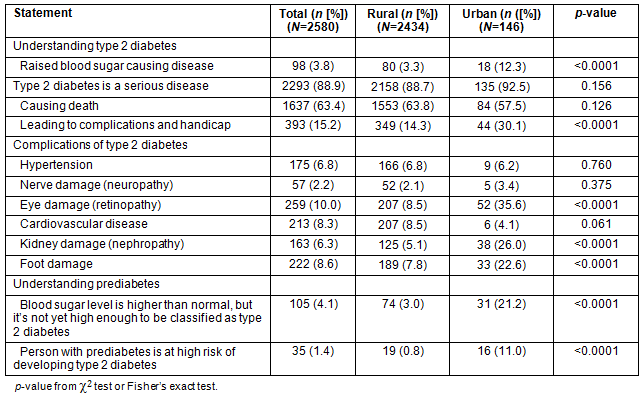
Table 2: Knowledge on risk factors and prevention of type 2 diabetes
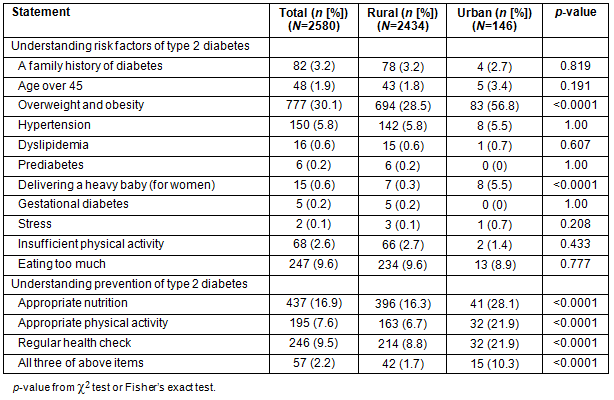
Table 3: Knowledge of type 2 diabetes treatment
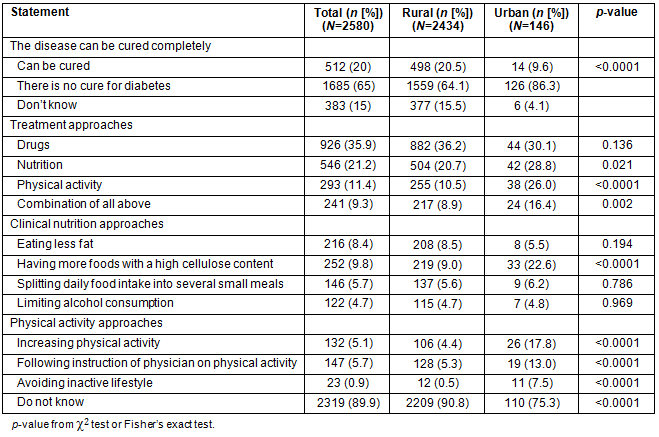
Table 4: Attitudes on prevention and treatment of type 2 diabetes
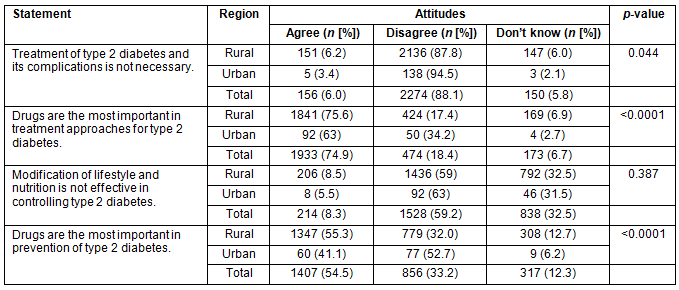
Table 5: Overall knowledge of control of type 2 diabetes
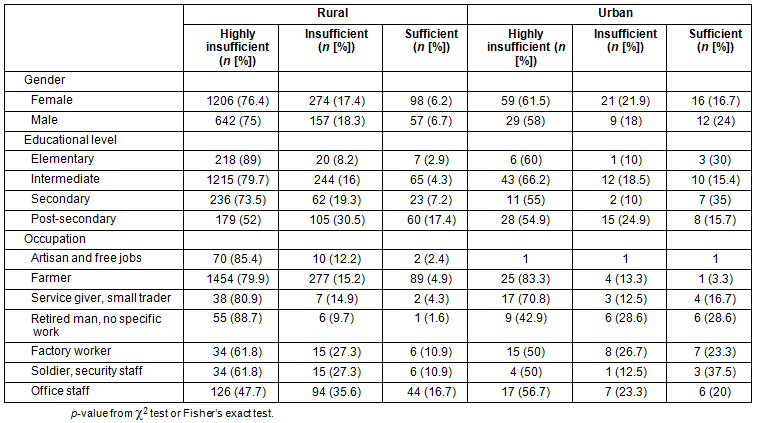
Table 6: Factors associated with inadequate knowledge on control of diabetes
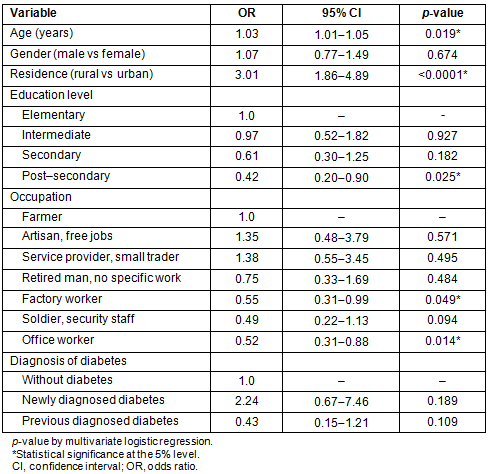
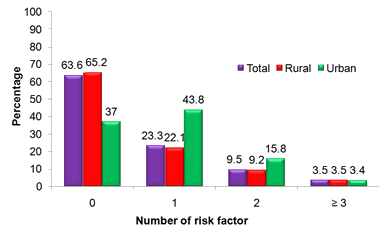
Figure 1: Knowledge of inhabitants about risk factors for type 2 diabetes. Data labels show the percentage of inhabitants who understood a number of risk factors.
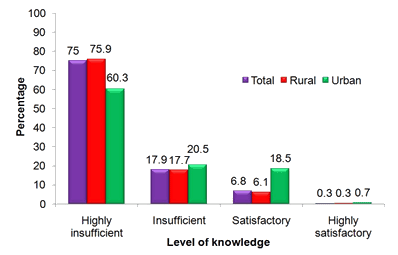
Figure2: Knowledge of inhabitants about control of type 2 diabetes. Highly insufficient (≤25 points), insufficient (26-50 points), satisfactory (51-75 points), highly satisfactory (>75 points).
Discussion
This was a large study with a representative sample recruited from the general population aged 40-64 years in a typical province of the Red River Delta region, Vietnam. The study showed the detailed picture of the overall knowledge of the rural and urban populations on T2D, including general awareness, risk factors, serious level, complications, prevention and treatment of the disease. On average, three in four (75%) inhabitants had highly insufficient, 17.9% had insufficient, 6.8% had satisfactory, and 0.3% had highly satisfactory levels of knowledge. Therefore, one could understand that the lack of awareness may lead to the fact that there were still 73% of diabetic subjects who do not know of the condition6.
Although different methods of evaluating the total score of knowledge of T2D exist among several studies, their findings can give evidence on the status of diabetes knowledge of populations. Rates of diabetes knowledge were found to be lower in developing countries than in developed countries8-16. In Kenya, the level of knowledge of diabetes in all regions is very poor: 27.2% of all inhabitants had good knowledge of diabetes and 41% demonstrated good practices towards diabetes8. In Mongolia, one in five Mongolians has never heard the term 'diabetes' prior to being interviewed and significantly more rural dwellers (26.6%) reported no knowledge than urban counterparts (15.6%)9. In India, similar studies show 20-25% of inhabitants are unaware of a condition called diabetes14,15. In Bangladesh, knowledge of diabetes and its risk factors is very limited in rural areas, even in persons diagnosed with T2D16. With regard to the rural-urban difference in knowledge and attitude towards T2D, the present study shows that inhabitants in urban areas had significantly better knowledge and attitude than those in rural areas. This difference has also been observed in Mongolia9 and in different regions of India17.
In Vietnam, a study in a province in the MeKong River Delta13 showed the very low comprehensive knowledge on T2D control: 83.7% of inhabitants had highly insufficient knowledge (correct answers to <25% of the total questions), 15.1% of inhabitants had insufficient knowledge (25-50% correct answers of the total questions), and only 1.1% of inhabitants had sufficient knowledge (≥50% correct answers of the total questions). This was in line with the study in Thai Binh Province of Northern Vietnam in 201118. Taken together, the insufficient knowledge of T2D has been recognized in different geographical regions. It indicates the urgent need for communication and education activities to improve the knowledge of the Vietnamese population on the disease, risk factors, serious level, complications, prevention and treatment of the disease.
One of the major findings of the present study was to depict the detailed gaps in knowledge of the general population. Less than 10% of the population understood the concept of T2D, its risk factors, complications, approaches of prevention and treatment. The problem that needs the most attention is that about 20% population in Ha Nam Province of the Red River Delta thought that 'Type 2 diabetes can be cured', while more than 65% thought that 'There is no cure for diabetes' and the rest did not know. It is consistent with the study in a province in the MeKong River Delta that showed that 60% population thought 'There is no cure for diabetes'13. Medically, a cure can be defined as restoration to good health. 'No cure' may give a very negative meaning and might make a person disappointed. The authors support the recommendations presented in a previous report19 that 'It may make sense operationally to consider prolonged remission of diabetes essentially equivalent to cure'. Therefore, it is very important that the opinion 'There is no cure for diabetes' is actively explained to the general population according to the previous recommendations19; and it must be a prerequisite for individuals and communities to take action on control of the disease.
To treat T2D, the three commonly accepted cornerstones are diet, physical activity, and medication20. Of the total population, 9.3% understood the necessary combination of the three approaches, 60% disagreed with the statement 'Modification of lifestyle and nutrition is not effective in controlling type 2 diabetes', <10% had knowledge of appropriate nutrition in T2D treatment, including eating less fat and more foods with a high cellulose content, splitting daily food intake into several small meals, and limiting alcohol consumption. A total of 90% of inhabitants did not know that 'physical activity approach is crucial to treat T2D'. Details on the gaps in T2D knowledge can provide evidence to local authorities and public health decision-makers to select the important and priority messages for communication and education activities to raise awareness about T2D control. Because age, residence, educational level, and occupation were the most significant factors associated with inadequate knowledge, these factors need to be taken into account in planning communication and education activities.
The present study had several limitations. First, only 35% of the study sample were men, showing that the sample was not likely to be representative of all men in the population. Second, group discussions or in-depth interviews were not conducted to collect qualitative data on knowledge of the general population on control of T2D to further explain the low knowledge of the studied cohort. Despite limitations, the study is the attempt of the authors to describe knowledge, attitude, and associated factors towards T2D, including general awareness, risk factors, complications, prevention and treatment of the disease.
The study shows a low level of diabetes awareness among the general population aged 40-64 years in Red River Delta, Vietnam, and a significantly lower awareness in rural areas than in urban areas. On average, less than one in ten inhabitants understood the concept of T2D, its risk factors, complications, approaches of prevention and treatment. Age, residence, educational level, and occupation were the most significant factors associated with inadequate knowledge. This low baseline of diabetes knowledge indicates the urgent need for communication and education activities to improve the knowledge of the Vietnamese population on T2D, risk factors, serious level, complications, prevention and treatment.
Acknowledgements
This study was supported by Vietnam's National Foundation for Science and Technology Development (NAFOSTED), grant no. 106.09-2012.04 from the Ministry of Science and Technology, Vietnam.
The authors would like to thank Dr Dang Dinh Thoang, Dr Pham Van Thang, and Mrs Nguyen Minh Thai for kind help and support. The authors acknowledge the health staff of the Ha Nam Center for Preventive Medicine for their cooperation and assistance.
References
1. Shaw JE, Sicree RA, Zimmet PZ. Global estimates of the prevalence of diabetes for 2010 and 2030. Diabetes Research and Clinical Practice 2010; 87: 4-14.
2. International Diabetes Federation. Global burden of diabetes. Diabetes Atlas. 6th edn. Brussels: International Diabetes Federation, 2013. Available: www.idf.org/diabetesatlas (Accessed 24 June 2014).
3. Binh VT, Uoc KH. Epidemiology of diabetes in Vietnam: treatment methods and preventive measures. Hanoi: Medical Publisher, 2005.
4. Vietnam Ministry of Health, National Hospital of Endocrinology. Annual report of the national programs for control of diabetes in 2012. Hanoi: 2013, p. 16.
5. General Statistics Office. The 2009 Vietnam Population and Housing Census: completed results. Hanoi: Statistical Publishing House; 2012. Available: www.gso.gov.vn (Accessed 6 July 2014).
6. Binh TQ, Phuong PT, Nhung BT, Thoang DD, Thang PV, Long TK, et al. Prevalence and correlates of hyperglycemia in a rural population, Vietnam: implications from a cross-sectional study. BMC Public Health 2012; 12: 939.
7. George A. Non-communicable disease: tomorrow's pandemics. Bulletin of the World Health Organization 2001; 79 (10): 907-915.
8. Kiberenge MW, Ndegwa ZM, Njenga EW, Muchemi EW. Knowledge, attitude and practices related to diabetes among community members in four provinces in Kenya: a cross-sectional study. Pan African Medical Journal 2010; 7: 2.
9. Demaio AR, Otgontuya D, de Courten M, Bygbjerg IC, Enkhtuya P, Oyunbileg J, et al. Exploring knowledge, attitudes and practices related to diabetes in Mongolia: a national population-based survey. BMC Public Health 2013; 13: 236.
10. Alele FO, Ilesanmi OS. Knowledge and attitude of a semi urban community in the south-south region of Nigeria towards diabetes mellitus. American Journal of Public Health Research 2014; 2(3): 81-85.
11. Rani PK Raman R, Subramani S, Perumal G, Kumaramanickavel G, Sharma T. Knowledge of diabetes and diabetic retinopathy among rural populations in India, and the influence of knowledge of diabetic retinopathy on attitude and practice. Rural and Remote Health 8(3): 838 (Online) 2008. Available: www.rrh.org.au (Accessed 15 August 2014).
12. Coulson F, Ypinazar V, Margolis S. Awareness of risks of overweight among rural Australians. Rural and Remote Health 6(2): 514 (Online) 2006. Available: www.rrh.org.au (Accessed 16 June 2014).
13. Trieu HV, Trinh LL, Vu LT, Nuong BK. A survey on knowledge, attitude, and practices of the general population for the control of diabetes in Dong Thap province. Scientific report of the Department of Health of Dong Thap Province, 2012.
14. Mohan D, Raj D, Shanthirani C, Datta M, Unwin N, Kapur A, et al. Awareness and knowledge of diabetes in Chennai - the Chennai urban rural epidemiology study. Journal of Association of Physicians of India 2005; 53: 283-287.
15. Shah VN, Kamdar PK, Shah N. Assessing the knowledge, attitudes and practice of type 2 diabetes among patients of Saurashtra region, Gujarat. International Journal of Diabetes in Developing Countries 2009; 29(3): 118-122.
16. Islam FM, Chakrabarti R, Dirani M, Islam MT, Ormsby G, Wahab M, et al. Knowledge, attitudes and practice of diabetes in rural Bangladesh: the Bangladesh Population Based Diabetes and Eye Study (BPDES). PLoS ONE 9(10): e110368. (Online) 2014. Available http://journals.plos.org/plosone/article?id=10.1371/journal.pone.0110368 (Accessed 28 July 2015).
17. Deepa M, Bhansali A, Anjana RM, Pradeepa R, Joshi SR, Joshi PP, et al. Knowledge and awareness of diabetes in urban and rural India. Indian Journal of Endocrinology and Metabolism 2014; 18(3): 379-385.
18. Quang LN, Ha NT, Viet NQ. Study on knowledge, attitude and practices about control of diabetes in ThaiBinh population, 2011. Vietnam Journal of Practical Medicine 2012; 7(834): 127-132.
19. Buse JB, Caprio S, Cefalu WT, Ceriello A, Del Prato S, Inzucchi SE, et al. How do we define cure of diabetes? Diabetes Care 2009; 32(11): 2133-2135.
20. Weinger K, Beverly EA, Smaldone A. Diabetes self-care and the older adult. Western Journal of Nursing Research 2014; 36(9): 1272-1298.


